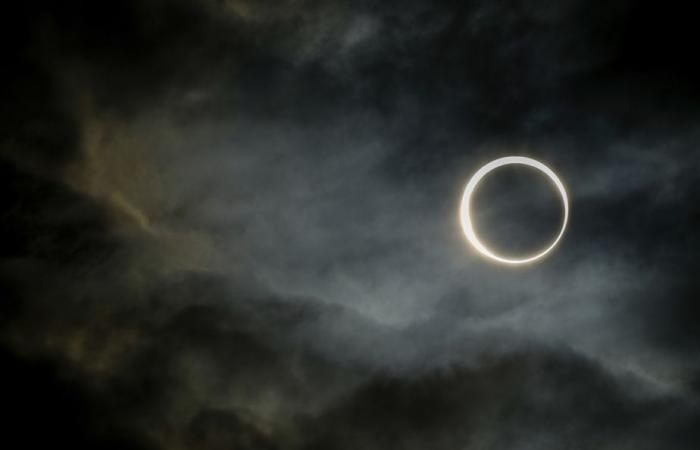(Puerto San Julian) Part of the Southern Hemisphere witnessed an annular solar eclipse on Wednesday, but with the splendor of the “ring of fire” perfectly visible to few people, in the semi-desert Chilean Patagonia and Argentina.
Posted at 10:39 a.m.
The southern tip of the continent and the (Chilean) Easter Island had the privilege of fully seeing the phenomenon, which began in the North Pacific and ended in the South Atlantic. But several South American countries and Pacific islands have been able to partially observe it.
“It was impressive, wonderful. Like a little twilight,” Ninoska Huki, 55, enthused to AFP from Easter Island with 7,000 inhabitants, 3,500 km from the Chilean coast, among the first to be able to observe the annular eclipse at the local midday, with the “Moai” statues in the background.
At the time of the ring of fire, “there was a lot of wind, which also contributed to the reflection, and a sublime moment where we were calm watching the eclipse. A magnificent twilight,” mused Mr. Huki.
“Special to the South”
Far on the other side of the Andes mountain range, in Argentine Patagonia, in Puerto San Julian, a small seaside resort 2,100 km from Buenos Aires, a few hundred duly covered people braved the cold and wind to watch the moon nibble away at the sun. around 5:25 p.m. local time (8:25 p.m. GMT), AFP noted.
Small telescopes, special eclipse glasses or… welding masks, the amateur astronomers, often locals who came with family, but sometimes enthusiasts who arrived from far away, enjoyed the phenomenon as much as the atmosphere of the place, at the end of the continent.
“I had seen a total eclipse, I was impressed, and from there I started following all the eclipses I could in Argentina,” commented Julio Fernandez, a 58-year-old retiree from Cordoba, at 2200 km. “But here it’s special because it’s far south.”
“I have already seen three eclipses [solaires] total, but it was my first “ring finger”. I came from Buffalo (north-eastern United States) just for that. And it was spectacular! » marveled Susan Patkin, 66 years old.
“A solar eclipse is the interposition of the Moon between the Sun and the Earth,” Diego Hernandez, responsible for scientific dissemination at the Buenos Aires Planetarium, reminded AFP. But in the case of Wednesday, “the Moon will be a little further from the Earth than usual, something that happens about once a month.”
Also, “the Moon cannot completely cover the Sun”, hence an orange ring, “a sort of ring of light coming from the Sun”. Before and after this ring of fire, a “crescent of the sun” is visible.
The eclipse began in the northern Pacific then from west to east, before “passing” through several islands and archipelagos, then crossing Chilean Patagonia, the Andes, Argentine Patagonia, to end in the Atlantic south.
If the eclipse phenomenon was to last more than three hours, from approximately 5 p.m. to 8:30 p.m. GMT, according to NASA, the perfect annular eclipse in a restricted band lasted only a few minutes.
Moon and sun, see you in March
It could be seen partially – that is to say without the “annularity” – from Bolivia, Peru, Paraguay, Uruguay, parts of Brazil, Mexico, New Zealand and several islands in the Pacific Oceans and Atlantic, according to NASA.
To admire the “ring of fire” in Argentina, you had to go to the province of Santa Cruz, an arid, cold and desert landscape, a huge province (the size of the United Kingdom) which is the second least densely populated in the country (after Tierra del Fuego), with 1.5 inhabitants per square kilometer, but with abundant wildlife of penguins, sea lions and seabirds.
An audience hardly comparable to the millions of Americans, from the North and the South, who in October 2023 were able to fully enjoy the last “ring of fire”, observable from Oregon to Colombia.
Wednesday’s eclipse, specifies the French Institute of Celestial Mechanics and Ephemeris Calculation (IMCCE), is the 18th.e annular solar eclipse of the 21ste century, and the second eclipse of 2024 after the total eclipse of April.
The next (partial) solar eclipse will take place on March 29, 2025, visible mainly from western North America, Europe and northwest Africa.






